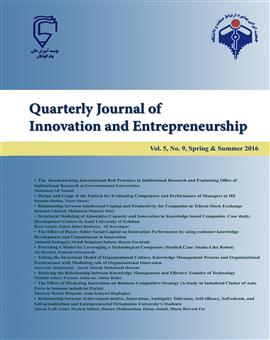Relationship between Intellectual Capital and Productivity for Companies in Tehran Stock Exchange
Subject Areas :rohollah ghabezi 1 , mahmood mousavi 2
1 - پژوهشگاه صنعت نفت
2 -
Keywords: Intellectual Capital, value added intellectual coefficient , calculated intangible value, productivity,
Abstract :
Abstract: Relationship between Intellectual Capital and Productivity for Companies in Tehran Stock Exchange. In this study, the relationship between intellectual capital as an important asset and competitive advantage has been discussed with productivity of the companies for Tehran Stock Exchange. To measure companies intellectual capital, two dimensions of capital efficiency (value added intellectual coefficient and its components) and value (calculated intangible value) is taken into consideration. For doing this work Information related through the years 2009 to 2013 for these companies have been collected. Hypotheses are tested by use of panel data regression. The results shows that the value added intellectual coefficient and its components (human capital efficiency, structural capital efficiency and efficiency of capital employed) have a significant and positive relationship with productivity. Also, the calculated intangible value of the company's efficiency has a significant and positive relationship only in models with fixed effects. The effect of the calculated intangible value components and value added intellectual coefficient on firm productivity, Test results shows that the efficiency of capital employed is the only factor for affecting productivity.
. امامي ميبدي،علي (1379). اصول اندازه گيري كارايي و بهره وري،موسسه مطالعات و پژوهشهاي بازرگاني،چاپ اول تهران.
2. حسن آبادي ،سعيد)1390(.توانمند سازي سرمايه هاي انساني عاملي موثر در افزايش بهره وري ،همايش جهاد اقتصادي با تاکيد بر بهره وري ملي، تهران، دانشگاه عالي دفاع ملي.
3. خاكي، غلامرضا (1376). آشنايي با مديريت بهره وري، انتشارات سايه نما،تهران،ايران.
4. رضائی ، فرزين؛ همتی حسن ؛کارگر شاملو ،بهرام (1389). سرمایه فکری و عملکرد مبتنی بر ارزش و سرمایه فکری، تحقیقات حسابداری، 2(7 )،صص 72 – 52.
5. رضايان ،علي ( 1390 ( . ماهنامه خبري _تحليلي اقتصادي، وزرات امور اقتصادي و دارايي ،سال دهم، 361،تهران ،ايران.
6. شاه ابادي،ابولفضل ؛ دهقانپور،محمد (1390(..بهره وري نيروي کار در بخش صنعت در اقتصاد ايران،همايش جهاد اقتصادي با تاکيد بر بهره وري ملي،دانشگاه دفاع ملي، تهران ،ايران.
7. عباسی، ابراهيم؛ گلدی صدقی،امرالله (1389) . بررسی تأثیر کارآیی عناصر سرمایه فکری بر عملکرد مالی شرکت ها در بورس تهران، بررسی های حسابداری و حسابرسی ، شماره17 ،صص 57- 74.
8. مدهوشی، مهرداد ؛ اصغر نژادامیری، مهدي (1388). ،سنجش سرمایه فکری و بررسی تاثیر آن با بازده مالی شرکتها، بررسیهای حسابداری و حسابرسی، 57 ، 101 - 116
9. نمازی ،محمد؛ ابراهیمی، شهلا (1388). بررسی تاثیر سرمایه فکری بر عملکرد مالی جاری و آینده شرکتهای پذیرفته شده در بورس اوراق بهادار تهران، تحقیقات حسابداری، شماره4، صص 4 – 25.
, J., Kujansivu, P. and Lonnqvist, A. (2005), Management accounting for intellectual capital, Proceedings of the7th Conference on Manufacturing Accounting Research.
11. Bontis,N.(1998), Intellectual Capital : An Exploratory Study That Develops Measures and Models , Management Decision, Vol. 36, No. 2,pp:63-76
12.Bontis, N. (1999), Managing organizational knowledge by diagnosing intellectual capital: framing and advancing the state of the field, International Journal of Technology Management, Vol.18, No. 8, pp:433-62
13.Bontis,N.&Chua Chong Keow,W & Richardson,S. (2000),Intellectual capital and business performance in Malaysian industries, Journal of Intellectual Capital, Vol .1 No .1,pp: 85-100
14.Brennan ,N. & Connell, B. (2000), Intellectual Capital : Current Issues and Policy Implication , Journal of Intellectual Capital. Vol 1 (3),pp: 206-240
15.Calisir,F.,Gumussoy,C.A&Bayraktaroglu,A.E.(2010), Intellectual capital in the quoted Turkish ITC sector, Journal of Intellectual capital, Vol. 11,No. (4),pp: 537-553
16.Chan,K.H. (2009),Impact of intellectual capital on organizational performance: an empirical study of companies in the Hang Seng Index ,The Learning Organization, Vol.16, No. 1, pp:4-21.
17.Chan, K.H.(2009), Impact of intellectual capital on organizational performance,an empirical study of companies in the Hang Seng Index (Part 2), The Learning Organization, Vol 16, No.1,pp: 22-39.
18.Diez,J.M.&Ochoa,M.L & Prieto,M.B. & Santidrian,A.(2010), Intellectual capital and value creation in Spanish firms, Journal of Intellectual Capital ,Vol. 11, No. 3, pp:348-367.
19.Firer, S. & Stainbank, L. (2003),Testing the relationship between intellectual capital and a company’s performance: evidence from South Africa, Meditari Accountancy Research, No.11, pp:25-44.
20.Ghosh,S. & Mondal,A.(2009), Indian software and pharmaceutical sector IC and financial performance,Journal of Intellectual Capital, Vol. 10, No.3, pp:369-388.
21. Kamath, G.B.(2008),Intellectual capital and corporate performance in Indian pharmaceutical industry, Journal of Intellectual Capital, Vol. 9 No. 4, pp:684-704
22.Kujansivu,P.&Lonnqvist,A(2007),Investigating the value and efficiency of intellectual Capital, Journal of Intellectual Capital, Vol .8 No .2,pp:272-287.
23.Patton, J.R. (2007), Metrics for knowledge-based project organizations,Academy of Management Journal, Vol .72, No.1,pp: 33-43.
24.Pulic, A. (2000), MVA and VAICTM Analysis of Randomly Selected Companies from FTSE 250, Austrian Intellectual Capital Research Center, Graz-London.
25.Pulic,A. (2004), Intellectual capital – does it creat or destroy Value ?, Measuring Business Excellence, Vol. 8, No .1, pp:62-68.
26.Singh,H.(2002),a review and analysis of the state of the art research on productivity measurment,industrial and data systems, Vol 100,No. 5,pp:234-241
27.Tangen, S. (2005),Demystifying productivity and performance, International Journal of Productivity and Performance Management, Vol, No.54 ,pp
: 34-4


